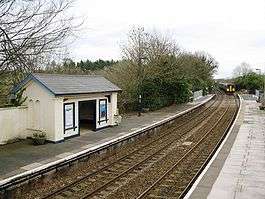Menheniot railway station
Menheniot railway station serves the village of Menheniot in Cornwall, England. It is 262 miles (422 km) from London Paddington via Bristol Temple Meads.
| Menheniot | |
|---|---|
 | |
| Location | |
| Place | Menheniot |
| Local authority | Cornwall |
| Coordinates | 50.427°N 4.410°W |
| Grid reference | SX289612 |
| Operations | |
| Station code | MEN |
| Managed by | Great Western Railway |
| Number of platforms | 2 |
| DfT category | F2 |
| Live arrivals/departures, station information and onward connections from National Rail Enquiries | |
| Annual rail passenger usage* | |
| 2014/15 | |
| 2015/16 | |
| 2016/17 | |
| 2017/18 | |
| 2018/19 | |
| History | |
| Original company | Cornwall Railway |
| Pre-grouping | Great Western Railway |
| Post-grouping | Great Western Railway |
| Opened | 1859 |
| National Rail – UK railway stations | |
| |
The station is managed by Great Western Railway, whose local trains serve the station.
History
%2C_Hay%2C_Liskeard%2C_Patricroft_%26_Uttoxeter_RJD_148.jpg)
The station opened with the Cornwall Railway on 4 May 1859.[1] It was described at the time as "of small extent, consisting of a departure station, a stone building, having a projecting roof thrown over the platform for the protection of passengers. At the 'arrival' side of the line a stone erection, with a covered seat, has been provided, but no enclosed room".[2] The following year saw two cottages built for the use of the railway staff working here. The "stone erection" is still in existence, used as a waiting shelter.[3]
The Cornwall Railway was amalgamated into the Great Western Railway on 1 July 1889. The Great Western Railway was nationalised into British Railways from 1 January 1948 which was privatised in the 1990s. Under British railways the staff were removed from the station and the station is now only served on request.[4]
Accidents
December 1873
On 2 December 1873 two goods trains arrived at the station where they could pass each other before resuming their journey on the single tracks towards St Germans and Liskeard. The crossing loop was not at that time equipped with starting signals. The train for the latter had a clear line and so the signalman called out "All right Dick," to the guard. Unfortunately the guard for the other train was also called Dick and so told his driver to start, but the line was not clear as another train was already on the way down from St Germans.
The accident illustrated the need for starting signals, block working, and some interlocking between the starting signals and the block instruments.[3]
February 1897
An accident occurred on 9 February 1897 during the reconstruction of Coldrennick Viaduct, which is situated just outside the station. A gang of 17 workmen were suspended below the viaduct on a platform when it broke away, throwing 12 of the men 140 feet to their deaths. Two of the gangers were criticised for not fixing safety chains and using poor quality wood for the platforms.[5]
November 1897
Another accident happened on 15 November 1897 during the reconstruction of nearby Treviddo Viaduct. On this occasion a rope gave way while five men were hoisting a wooden beam up onto the new viaduct. One of them let go of his rope too soon, this meant that the wood swung free and knocked two of the gang to their deaths.[5]
Services
Menheniot is served by a limited number of the Great Western Railway trains on the Cornish Main Line between Penzance and Plymouth, mainly at peak periods. Most trains only call on request (which means that people wishing to alight need to inform the guard, and those wishing to join the train here need to signal clearly to the driver). There is one train per day to London Paddington at 07:34. Menheniot is a compulsory stop for this service.[6][4]
Menheniot receives two trains per day on Sundays in both directions.[6]
| Preceding station | Following station | |||
|---|---|---|---|---|
| St Germans | Great Western Railway Cornish Main Line |
Liskeard | ||
References
- MacDermot, E T (1931). History of the Great Western Railway, volume II 1863-1921. London: Great Western Railway.
- West Briton and Cornwall Advertiser, 1859 (Railway Special Edition)
- Bennett, Alan (1990). The Great Western Railway in East Cornwall. Cheltenham: Runpast Publishing. ISBN 1-870754-11-5.
- GB eNRT, May 2017 Edition, Table 135
- Holgate, Mike (2006). Murder and Mystery on the Great Western Railway. Tiverton: Halsgrove. ISBN 1-84114-556-4.
- "GWR December 2019-May 2020 timetable" (PDF). 15 December 2019. Retrieved 23 February 2020.
External links
| Wikimedia Commons has media related to Menheniot railway station. |